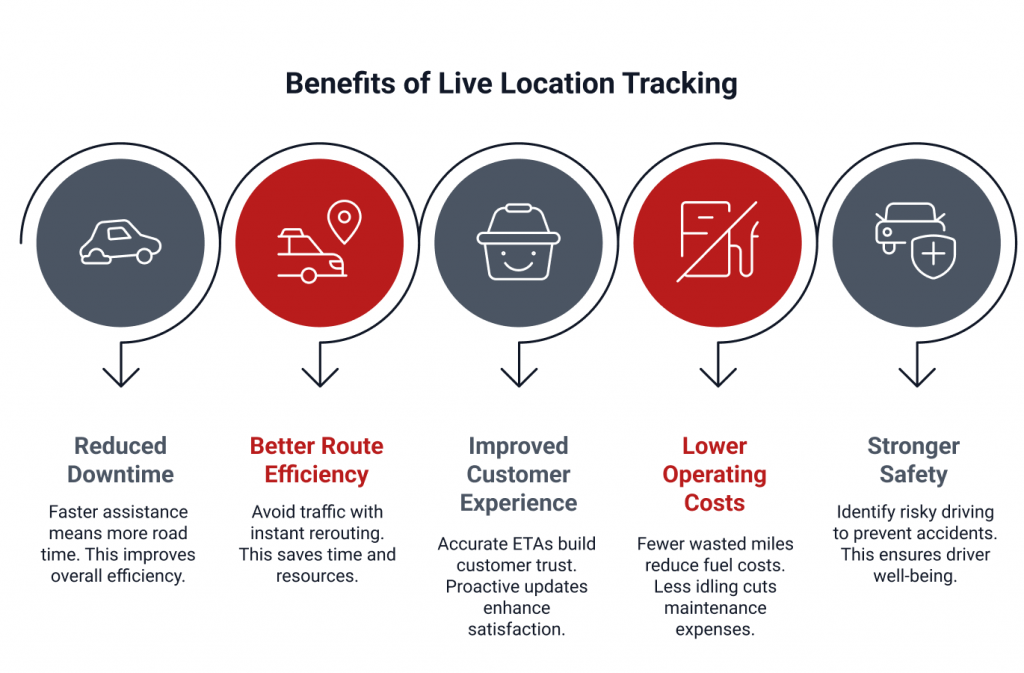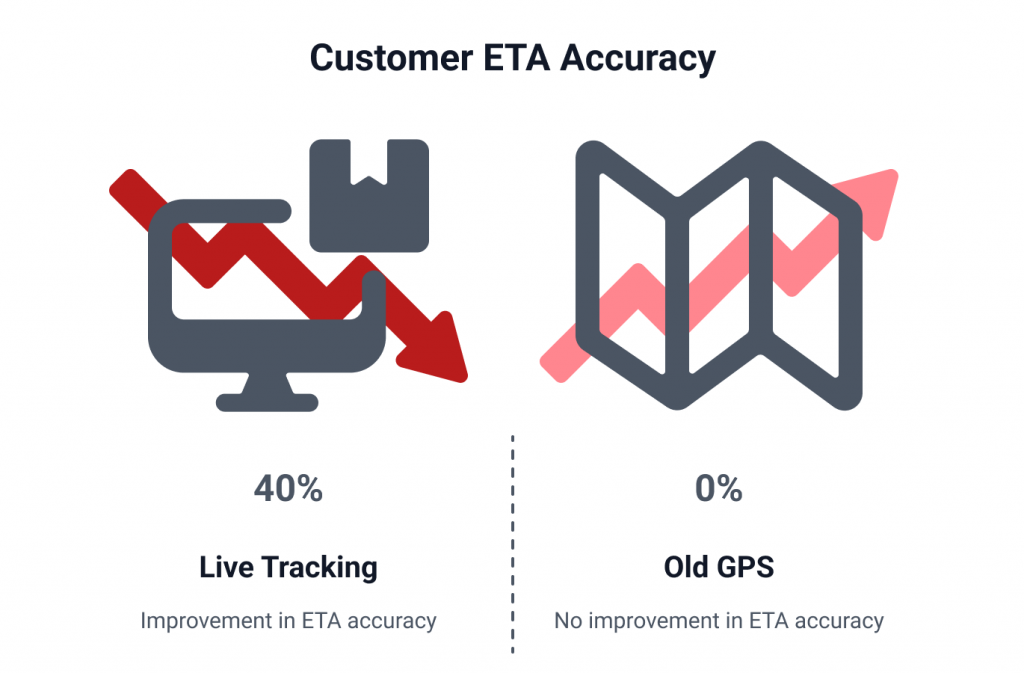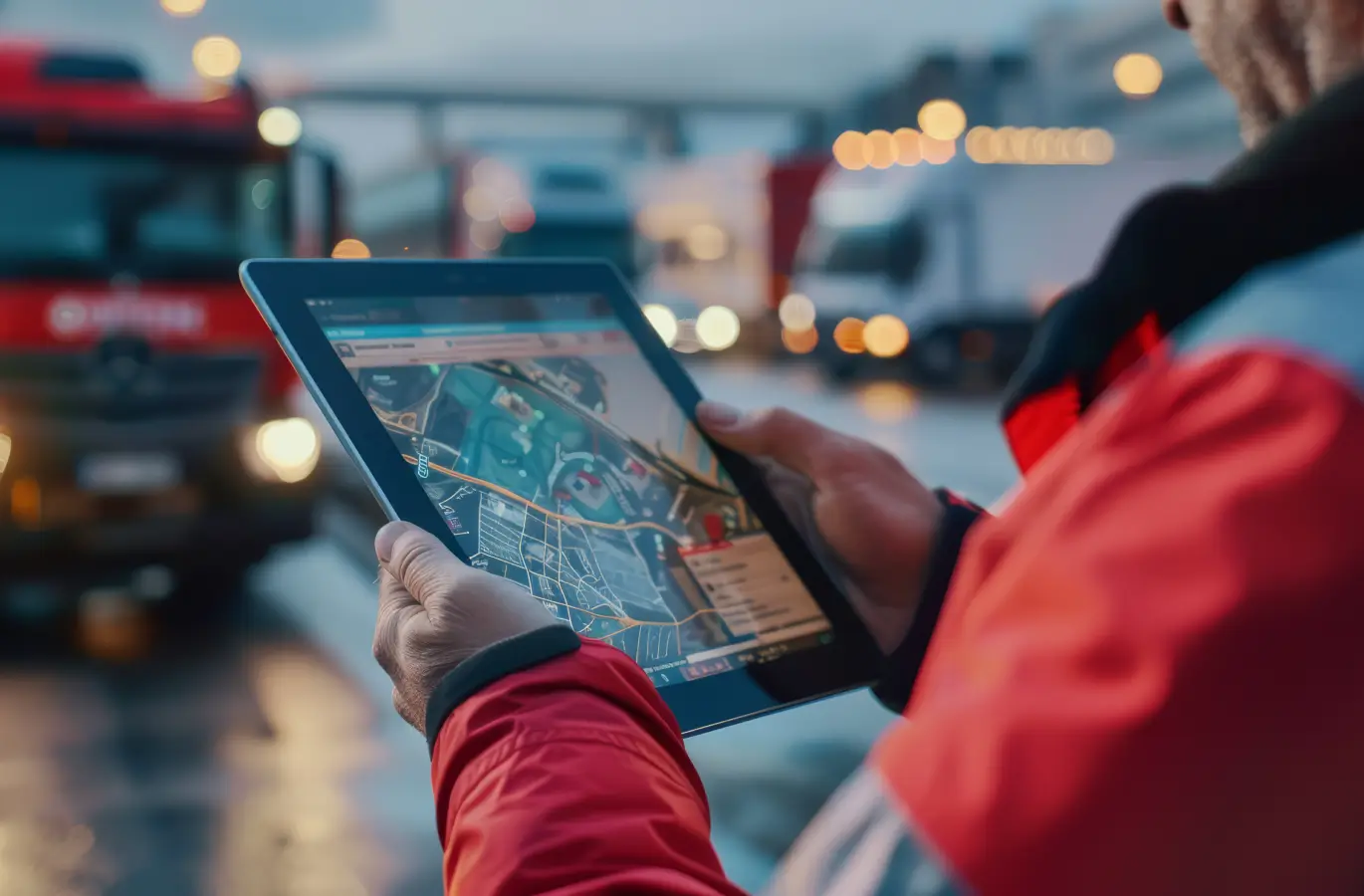A decade ago, “tracking your fleet” meant opening a map, waiting for dots to load, and hoping they told a complete story. Today, live location tracking in fleet operations is more than a map — it is the backbone of dispatch, safety, maintenance, and customer service, all working in sync.
Imagine this.
It is 9:02 a.m., and your dispatch dashboard shows every truck, van, or trailer as a moving marker. One driver is five minutes ahead of schedule, so you slot in an extra stop. Another hits heavy traffic two exits ahead, so you reroute them before the delay turns into a customer complaint. A refrigerated truck sends a temperature warning, and you immediately notify the team at the destination to be ready for a quick unload.
Meanwhile, a driver with a sudden mechanical issue sends an alert that triggers REACH to line up the right roadside technician without a single phone call from your end.
This is the difference between real-time fleet tracking and old-school GPS. You are not just watching vehicles. You are using live GPS vehicle tracking as an operating system for the road — one that powers quick decisions, accurate ETAs, and fewer costly surprises.
Why it matters now
- Customer expectations are instant. Whether you are delivering parts, fuel, or produce, buyers now expect accurate ETAs that adjust automatically.
- Margins are tight. Fuel costs, driver shortages, and unpredictable maintenance make every minute matter. Live tracking turns minutes saved into measurable revenue.
- Incidents are inevitable. From flat tires to road closures, you cannot stop every disruption, but you can respond in seconds if you know exactly what the issue is and where it is.
For fleets that want to stay competitive, live tracking has moved from “nice-to-have” to “must-have.” And for fleets that want to act faster than the competition, pairing tracking with a platform like REACH means those dots on the map instantly turn into service calls, reroutes, and real fixes.
From Basic GPS to Real-Time Telematics
Fleet tracking did not start glamorously. In its earliest days, it meant installing a GPS unit in each vehicle that pinged its coordinates to a server every few hours. You could tell roughly where your vehicles had been, but you were always looking at the past. If a truck broke down at 2 p.m., you might not know until a frustrated customer called asking where it was.
Then came real-time GPS tracking, and everything changed. Instead of stale snapshots, fleet managers started getting live updates every few seconds. But that was only the beginning. The real revolution came when GPS data merged with fleet telematics — the sensors and systems that capture vehicle speed, engine status, fuel levels, temperature, and even driver behavior.
Now, modern fleet telematics systems create a live data feed that is far more than a map. You can see:
- Exactly when a vehicle leaves a location and how long it spends at each stop
- Real-time speed and driving patterns to spot unsafe behavior before it causes an accident
- Engine diagnostics that help prevent costly breakdowns by catching small issues early
- Cargo-specific metrics like temperature for refrigerated loads, ensuring compliance, and quality
The leap from basic GPS to advanced telematics is like moving from a flip phone to a smartphone. You are not just tracking location anymore; you are managing the entire health and performance of your fleet.
Why this matters for operations
In a competitive market, information is power. Knowing where your vehicles are is good. Knowing their condition, how they are being driven, and whether they can make the next delivery without a problem is better. This visibility allows you to cut downtime, reduce fuel waste, keep drivers safer, and give customers the confidence that their goods will arrive on time and in perfect condition.
Where REACH stands out
Most platforms can show you a location on a map. REACH goes further by linking that location data with a 24/7 vendor network that can respond to any incident — from a tire blowout to a dead battery — right where it happens. It is live location tracking with the power to act instantly, turning potential delays into quick recoveries.
Live Location Tracking vs. Old-School GPS

The Business Impact of Live Location Tracking
For fleet managers, live location tracking is not just about knowing where a vehicle is. It is about running a tighter, faster, and more reliable operation that translates directly into profit. When every vehicle movement is visible in real time, the ripple effects touch every part of the business.
- Reduced Downtime
Every hour a truck sits idle due to a breakdown, missed connection, or routing issue is an hour it is not generating revenue. With live GPS vehicle tracking, you can react instantly to disruptions. If a tire blows out, you know exactly where the vehicle is, what the problem is, and how to get it moving again. With REACH, that reaction is even faster because the system automatically connects you to the nearest qualified service provider. - Better Route Efficiency
Traffic jams, road closures, and last-minute customer requests can derail a day’s plan. Live tracking gives dispatchers the power to reroute on the fly, keeping drivers on the fastest, most efficient path. Over time, this means lower fuel consumption, less wear on vehicles, and happier drivers who spend less time stuck in traffic. - Improved Customer Experience
Customers no longer want vague delivery windows. They want accurate ETAs and immediate updates if anything changes. Live tracking makes this easy. When you can see exactly where a delivery vehicle is, you can give customers updates they can trust. That transparency builds loyalty and trust, and it often becomes a competitive advantage that keeps customers coming back. - Lower Operating Costs
Small inefficiencies add up fast. A few extra miles per day per vehicle can mean thousands in extra fuel costs over the year. With fleet location tracking systems, managers can spot and correct inefficient routes, excessive idling, or unnecessary stops. That operational discipline directly impacts the bottom line. - Stronger Safety and Compliance
When driver behavior data is part of the tracking system, managers can address risky driving patterns before they lead to accidents or violations. This not only protects your team but also reduces insurance claims and compliance fines.
Why REACH Makes a Difference
Plenty of systems can track your fleet’s location. Fewer can connect that tracking to real-world solutions in minutes. REACH combines live location visibility with a 24/7 vendor network and service coordination, making it a tool that delivers both information and action. The moment you see a problem; the fix is already on the way.
Technology Trends Shaping the Future of Live Location Tracking
Live location tracking is no longer static technology. It is evolving at a rapid pace, fueled by advances in GPS accuracy, telematics integration, and cloud-based analytics. The fleets that understand these trends will be the ones that stay ahead in efficiency, safety, and customer satisfaction.
- Ultra-Precise GPS and IoT Connectivity
Older GPS systems could be off by several meters, which was fine for general location checks but less helpful in dense urban environments. Now, new-generation GPS chips paired with IoT (Internet of Things) sensors can pinpoint vehicles with near real-time precision. This level of accuracy means a dispatcher can tell if a truck is on the correct dock, not just at the correct facility. - Predictive Insights from Telematics Data
While predictive maintenance is not a feature of REACH, preventative maintenance still plays a critical role. By monitoring vehicle performance metrics like engine temperature, battery voltage, and brake wear, telematics can alert managers to potential problems before they escalate. This keeps vehicles on the road longer and reduces the cost and disruption of emergency repairs. - Integration with Driver and Customer Apps
Live location data is most powerful when it is shared in real time with everyone who needs it. Drivers can see optimal routes and updated job assignments without returning to the depot. Customers can track deliveries directly, reducing “Where is my order?” calls and building trust through transparency. - AI-Driven Dispatch and Resource Allocation
Artificial intelligence is making its way into fleet management software, where it can analyze live tracking data and recommend the best allocation of vehicles, routes, and resources. This can reduce idle time, prevent bottlenecks, and ensure that service crews or delivery drivers are always deployed most efficiently. - Stronger Data Security and Compliance
As live tracking becomes more integrated into day-to-day operations, protecting that data is essential. Modern systems encrypt location and telematics data to prevent unauthorized access, helping fleets meet regulatory requirements and maintain customer confidence.
Why REACH is Ready for the Future
REACH is built to adapt. Its live tracking features are designed to integrate with vendor networks, dispatch systems, and service workflows in a way that scales with technology. That means as GPS accuracy, IoT connectivity, and AI dispatching improve, REACH’s ability to respond instantly to issues will only get stronger.
The Business Benefits of Live Location Tracking

Why REACH Becomes the Obvious Choice
When a vehicle is out on the road, anything can happen. A flat tire on a busy highway. A breakdown in the middle of a delivery run. A sudden route change because of traffic or weather. In moments like these, you do not just need to know where your vehicle is — you need to get it moving again as fast as possible.
That is where REACH changes the game. It takes live location tracking and pairs it with an always-on network of vetted service providers across the country. The moment something goes wrong, you don’t waste time searching for help or making a dozen calls. REACH connects you directly to the right solution, whether it is towing, roadside repair, or specialized service.
For you, that means less downtime, more completed jobs, and fewer headaches. For your drivers, it is the confidence that support is just a tap away. For your customers, it is a reassurance that their delivery or service will still arrive as promised, even when the unexpected happens.
Other systems may stop at showing you a map. REACH takes you several steps further by turning that map into an action plan. Every mile your fleet runs is supported, protected, and managed in real time.
If you want a fleet management partner that works as hard as you do to keep things moving, REACH is it. No wasted time. No lost opportunities. Just a faster, safer, more reliable way to run your fleet — every single day.
Key Takeaways
Live location tracking is now the backbone of fleet operations
It powers everything from dispatch and routing to safety, maintenance, and customer satisfaction—turning real-time visibility into better decision-making.
REACH transforms GPS data into action
Unlike platforms that stop at maps and dots, REACH connects live vehicle locations with an always-on vendor network to resolve breakdowns and service issues in minutes.
Real-time telematics is a game-changer
Fleet tracking has evolved from simple GPS to dynamic data systems. Modern telematics now delivers speed, diagnostics, temperature, and driving behavior data in real time.
Fleets save time, fuel, and money.
By reacting instantly to disruptions, optimizing routes on the fly, and minimizing unnecessary mileage and idling, live tracking directly enhances operational efficiency and bottom-line results.
Customer expectations demand real-time ETAs.
Today’s buyers expect accurate delivery windows and instant updates. Live tracking enables that transparency, creating a smoother customer experience and building brand loyalty.
REACH closes the gap between visibility and response
Seeing a problem on a map is one thing. Solving it is another. REACH helps fleets act fast by linking GPS data to instant vendor dispatch for towing, repairs, and more.
Technology is pushing the limits of what’s possible
Ultra-precise GPS, IoT sensors, AI-based dispatching, and secure cloud infrastructure are shaping the next generation of live location tracking.
A proactive, resilient fleet starts with visibility
You can’t prevent every issue, but with the right tracking tools in place, you can always be ready to respond, reroute, and recover—before small problems become big setbacks.
Frequently Asked Questions
-
What is live location tracking in fleet management?
Live location tracking is a GPS-enabled feature that lets fleet managers see the exact location of each vehicle in real time. It helps improve dispatch decisions, reduce downtime, and keep drivers and customers informed.
-
How is live tracking different from standard GPS tracking?
Standard GPS updates location data at fixed intervals, sometimes every few minutes or hours. Live tracking updates in near real time, often every few seconds, and can also provide details like speed, route, and vehicle health.
-
Can live location tracking help reduce downtime?
Yes. With platforms like REACH, live tracking is linked to a 24/7 network of service providers. This means that if a vehicle breaks down, help can be dispatched immediately, getting the vehicle back on the road faster.
-
Is live tracking useful for preventative maintenance?
Definitely. Live tracking data can be combined with usage and performance metrics to schedule preventative maintenance before issues become costly problems.
-
Does live location tracking improve customer service?
Yes. Accurate ETAs and proactive updates based on real-time location build customer trust and reduce complaints about delays.
-
How secure is live location tracking data?
Reputable fleet tracking systems encrypt location data and use secure connections to ensure privacy and protect against unauthorized access.



